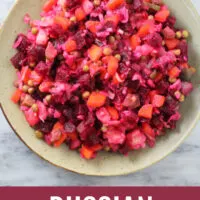This Russian Vinaigrette Salad (винегрет) showcases a colorful medley of beets, carrots, potatoes, pickles, onion, sauerkraut, and green peas dressed with sunflower oil and salt.
While traditionally served during the colder months of the year, this refreshing, cold dish is also great in the summer!
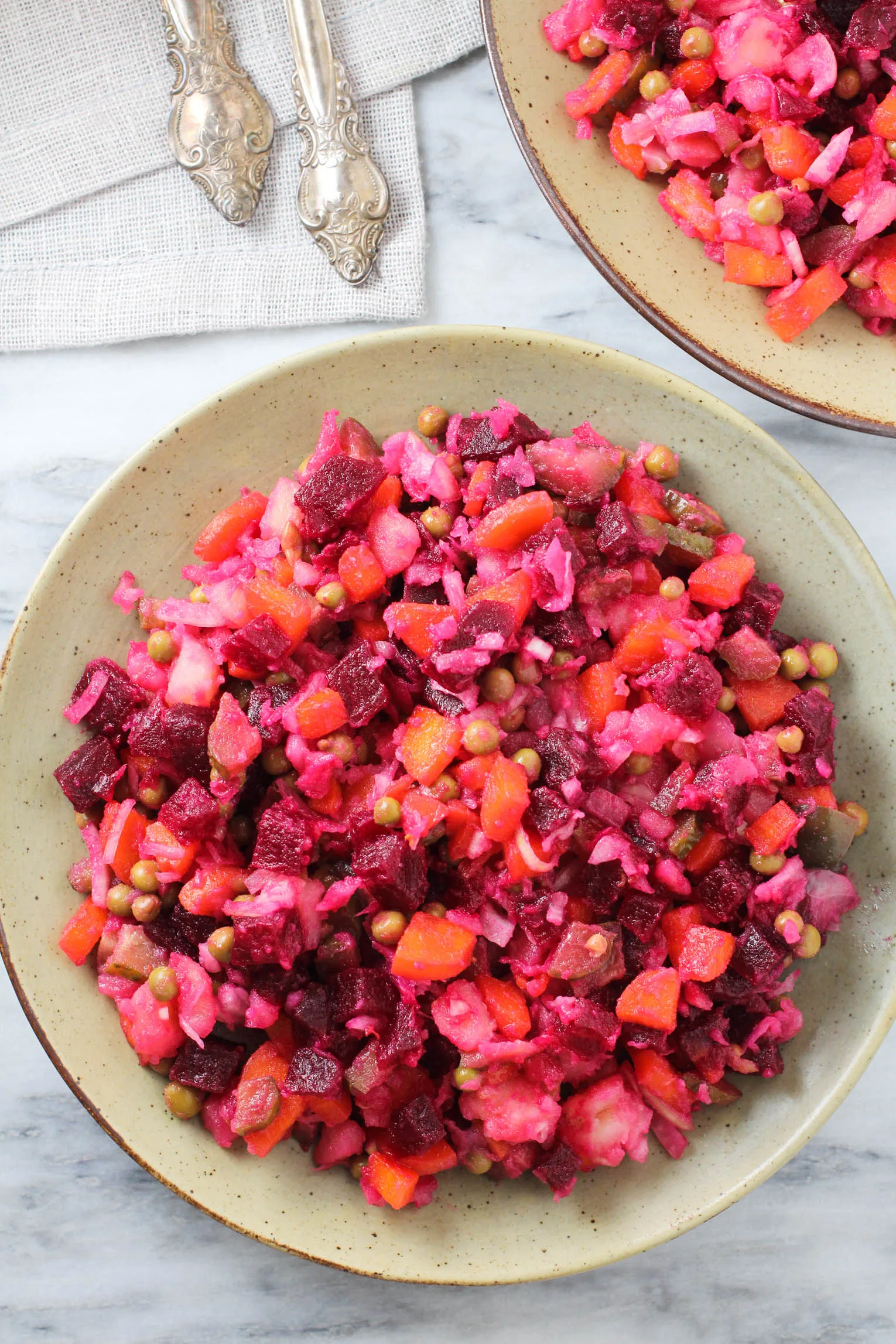
Russian cuisine encompasses a myriad of delicious, humble dishes, and one such beet salad known as vinegret, vinaigrette, or винегрет.
With its vibrant colors and dimensional flavor profile, this salad is a staple of Russia’s rich culinary heritage.
So, whether you’re a salad enthusiast or simply exploring recipes from around the world, this post will guide you through the ingredients and preparation of an authentic Russian Vinaigrette salad.
Let’s get started!
What is Vinegret?
Vinegret is a traditional Russian beet salad consisting of cooked beets, potatoes, carrots, pickles, sauerkraut, and onions. However, slight ingredient variations are common depending on the region and the cook’s creativity!
Although the salad’s name is derived from the French word “vinaigrette,” Russian vinegret salads don’t typically contain vinegar or vinaigrette dressing.
Instead, the tender cooked vegetables are diced and dressed simply with unrefined sunflower oil and salt.
This beloved beet salad is served as a side dish or appetizer at almost all Russian restaurants and is a mainstay during special occasions and celebrations, like birthday parties, weddings, and winter holidays – especially New Year’s.
Why You’ll Love This Recipe
Here are three reasons why this Russian salad recipe is a keeper:
- It’s the perfect salad for cold weather. Vinegret is usually prepared during the winter months because root veggies are readily available during this time of year. In addition, they take a long time to boil and can heat up your home in the process, which isn’t ideal during hot summer.
- It’s nutritious and just plain delicious. This salad is a popular vegan option known for its assortment of hearty vegetables rich in vitamins and minerals.
- It’s great for meal prep. You can make a big batch and serve it for two to three days.
Vinaigrette Salad Ingredients
Here’s everything you’ll need for my version of vinaigrette salad:
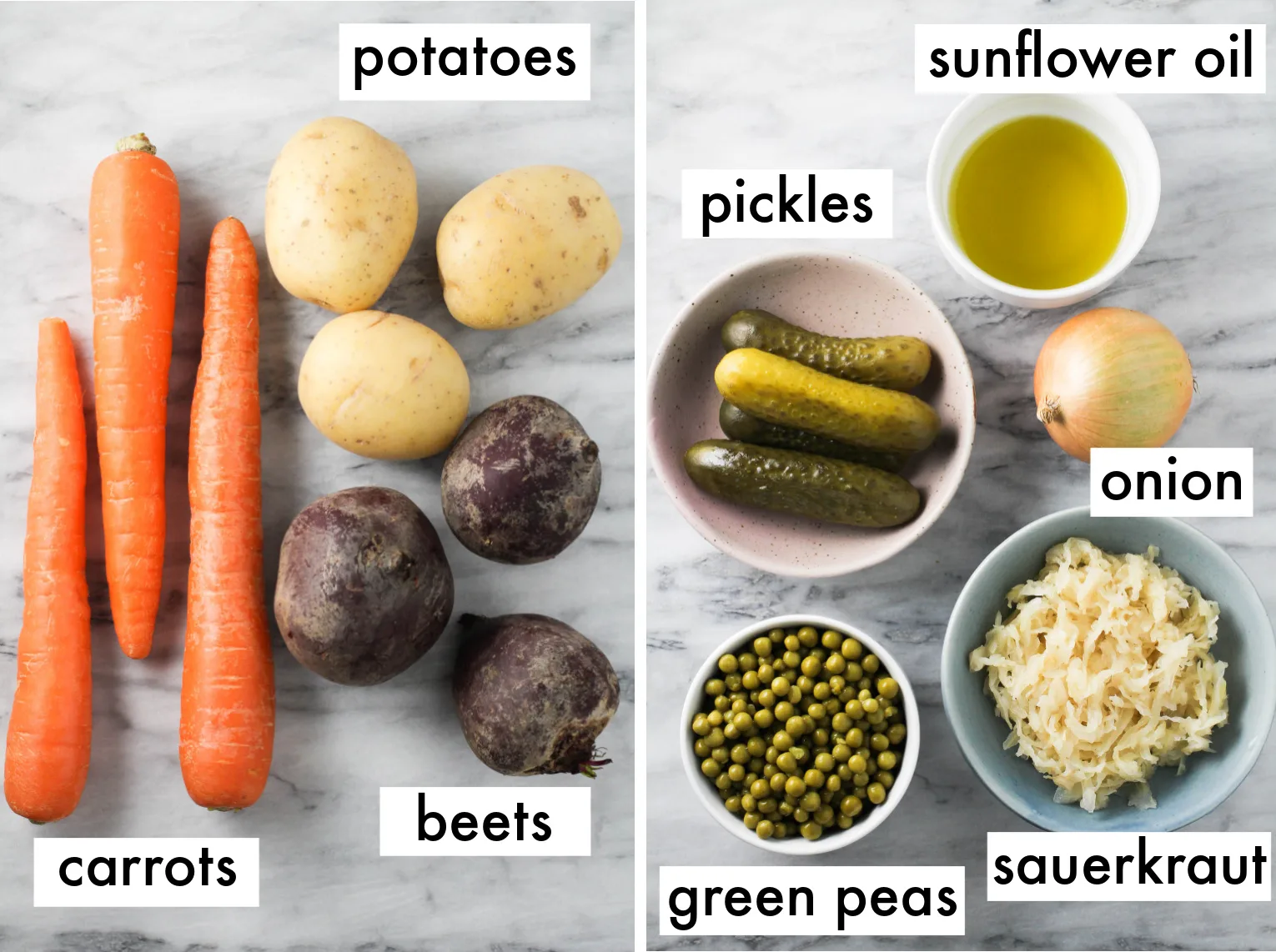
Here is a brief overview of the ingredients:
- Beets – Add a vibrant, earthy element. To learn more about preparing beets, check out this article on how to cook beets.
- Carrots – Provide a touch of savory-sweetness. To learn more about preparing carrots, check out this article on the best ways to cook carrots.
- Potatoes – Offer a comforting, stick-to-your-bones base. Opt for waxy potato varieties, such as Yukon Gold and red potatoes, as they hold their shape well and have a creamy texture that works well in salads.
- Onion – Red or sweet onion provides a pleasant mild pungency that helps balance the flavors.
- Pickled Cucumbers – Specifically, “sour pickles” or “brined pickles” offer a delectable tangy crunch. You can use dill or half-sour pickles if you can’t find sour pickles. Just squeeze the extra liquid from the pickles before chopping them.
- Sauerkraut – Adds a unique tanginess to the overall flavor profile. I recommend using plain, unflavored sauerkraut, so the natural flavors of the other ingredients can infuse the fermented cabbage. If your sauerkraut has long strands, be sure to trim them.
- Canned green peas – Add a burst of vibrant green color and sweetness. You can also use frozen peas, but make sure to blanch them beforehand.
- Unrefined sunflower oil – Ties the salad together with a “nutty” flavor that doesn’t overpower the other ingredients.
- Salt – Enhances the natural sweetness and flavors of the salad ingredients.
How to Make Russian Vinaigrette Salad
Here are the step-by-step instructions on how to make a classic Russian vinaigrette salad:
Step 1: Boil the beets.
Place the beets in a medium pot, cover them with at least 3 inches of water, and bring the water to a boil.
Then, reduce the heat, cover, and let the beets simmer until they are tender (about 1- 1½ hours, depending on the size of the beets).
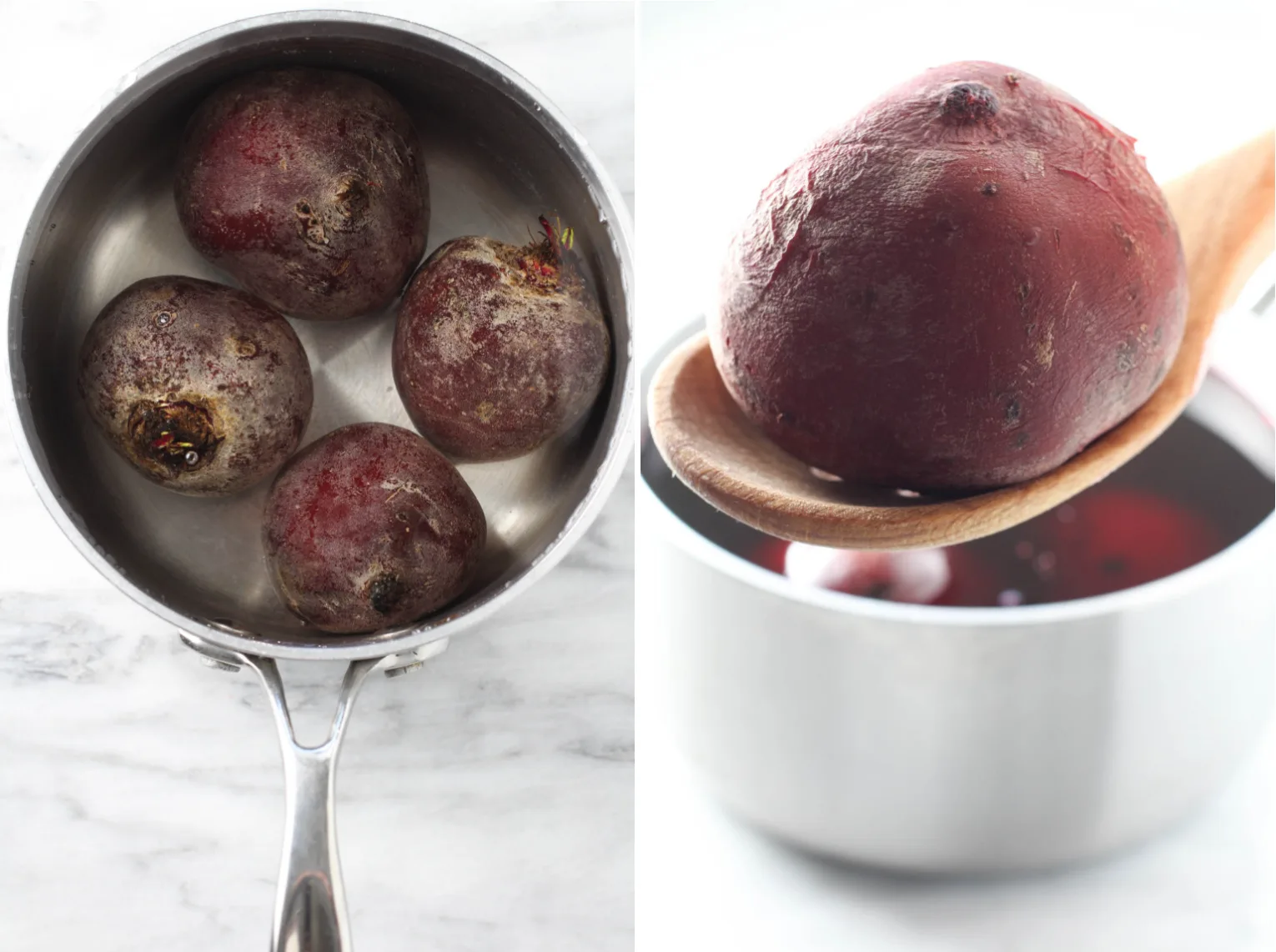
Step 2: Boil the potatoes and carrots.
Place the potatoes and carrots in a separate pot, cover them with 2-3 inches of water, and bring the water to a boil.
Then, reduce the heat, cover, and let the veggies simmer until tender (about 25-35 minutes).
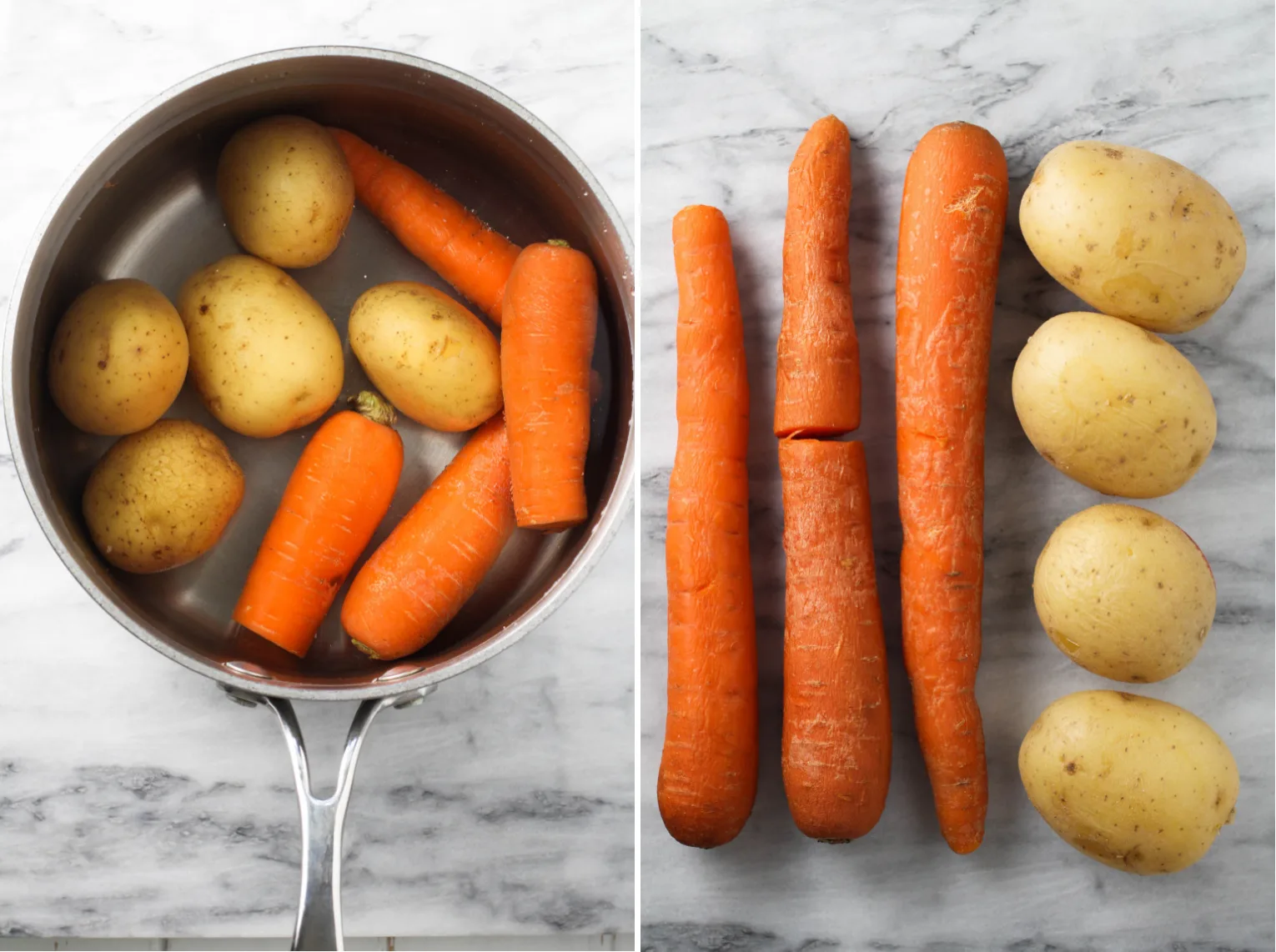
Step 3: Cool and chop the vegetables.
Drain the boiled vegetables and let them cool completely (I place them in the fridge overnight).
Then, peel and dice the potatoes, beets, and carrots, and slice the onion and pickles.
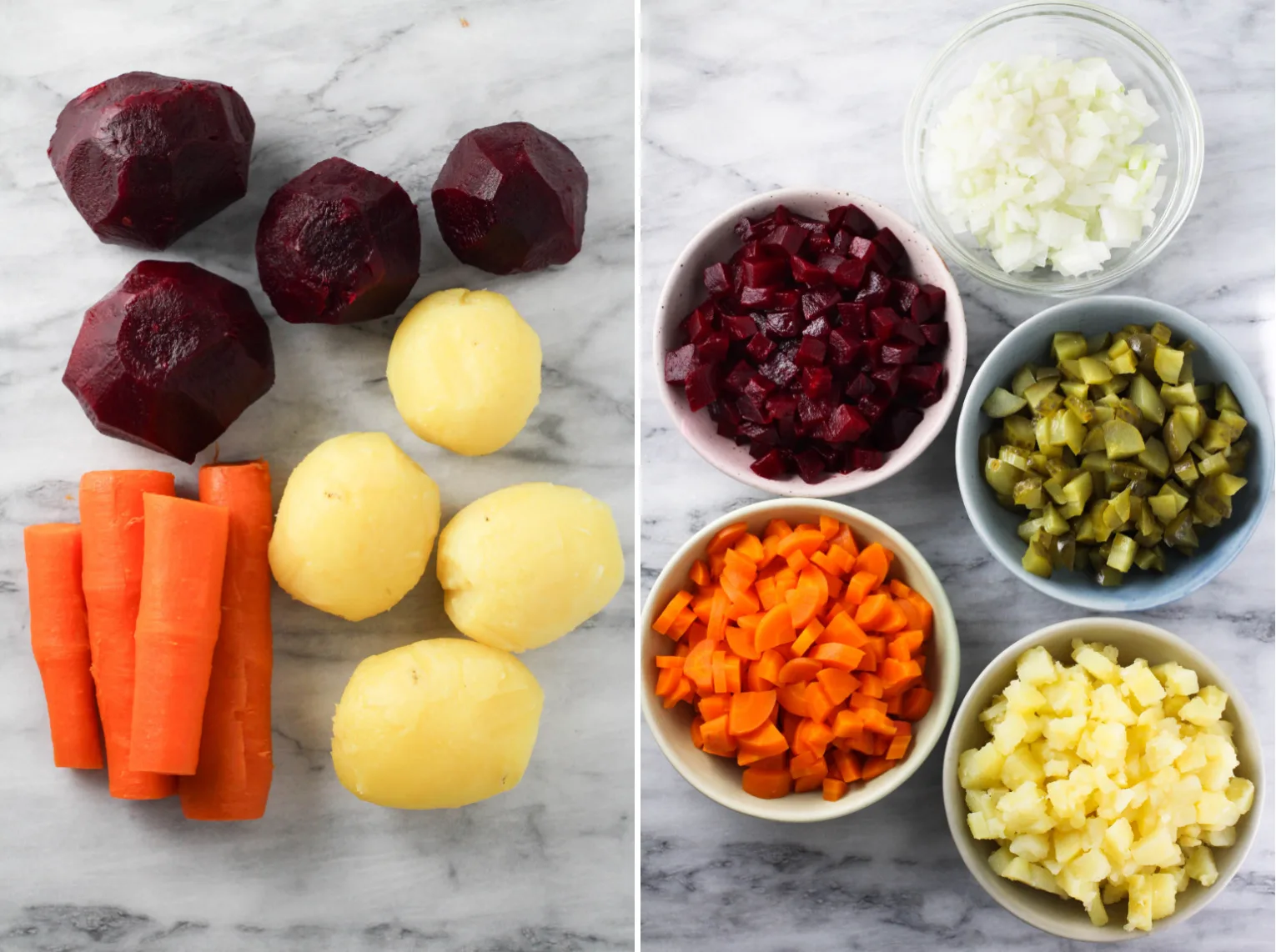
Step 4: Toss the salad and chill.
Add the beets, potatoes, carrots, onion, pickles, sauerkraut, green peas, and oil to a large bowl.
Season with salt to taste, and toss to combine. Place the bowl in the fridge for about 30 minutes to 1 hour before serving.
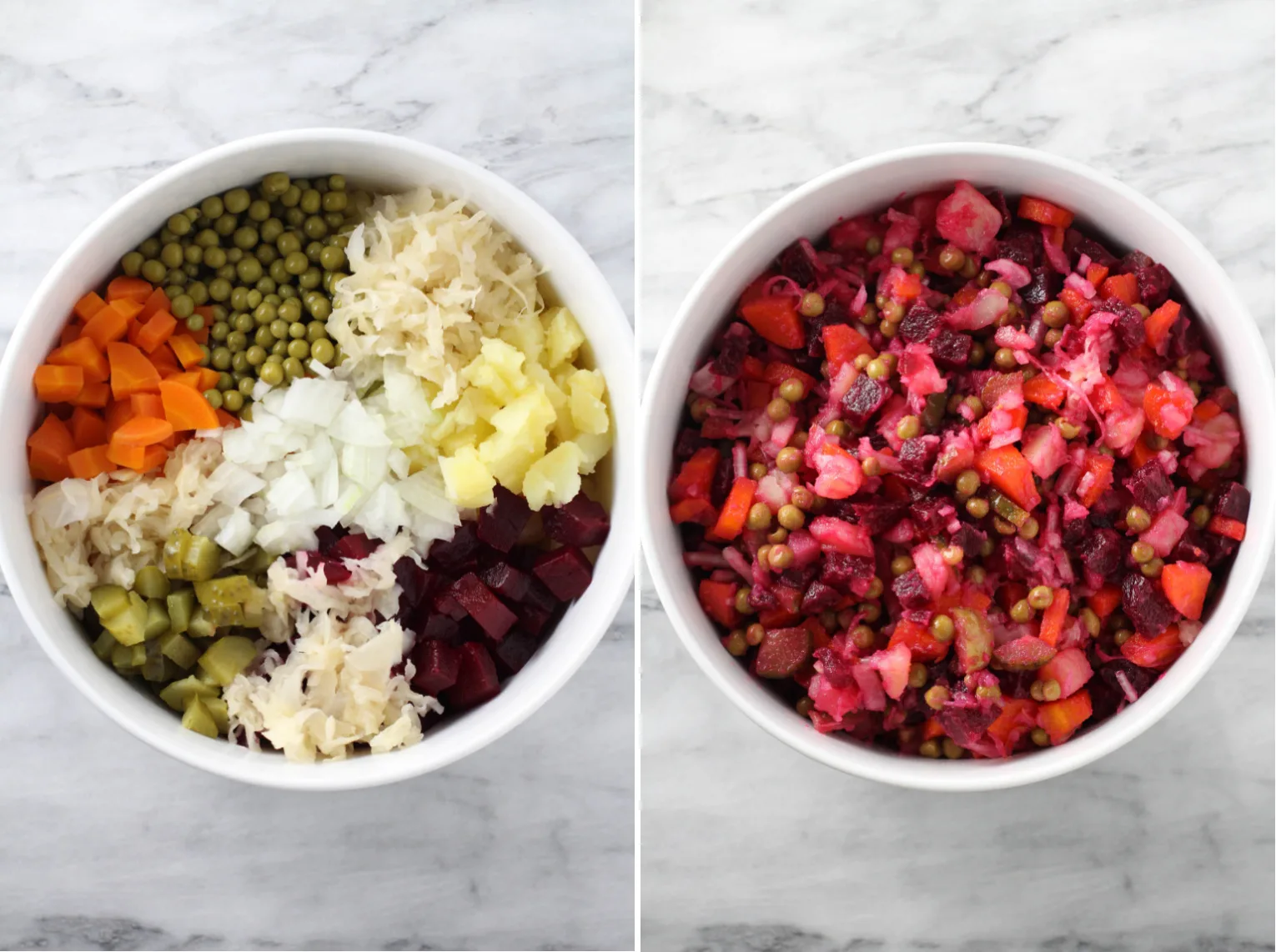
Recipe Tips
Here are a few tips to help you make the best vinegret salad:
- Cook the veggies evenly: The beets, potatoes, and carrots should be cooked until tender but not mushy, so promptly remove them from the boiling water and let them cool down before peeling and dicing.
- Chill the boiled vegetables: After cooking the beets, potatoes, and carrots and letting them cool, you can set them in the refrigerator overnight to help reduce the excess moisture and firm them up.
- Prevent the beets from bleeding: Toss the beets with about half of the oil in a separate bowl. Then, gently toss the oiled beets with everything else. This technique won’t entirely eliminate the color transfer but will help minimize it.
- Taste before salting: You may find the sauerkraut provides enough salt, so it’s always best to taste vinaigrette salad before adding more.
- Chill before serving: Let the salad rest in the fridge for at least 30 minutes before serving so the flavors can fully develop and meld together.
- Add the potatoes with care: If you aren’t serving the salad the same day, keeping the potatoes separate and adding them just before serving is best.
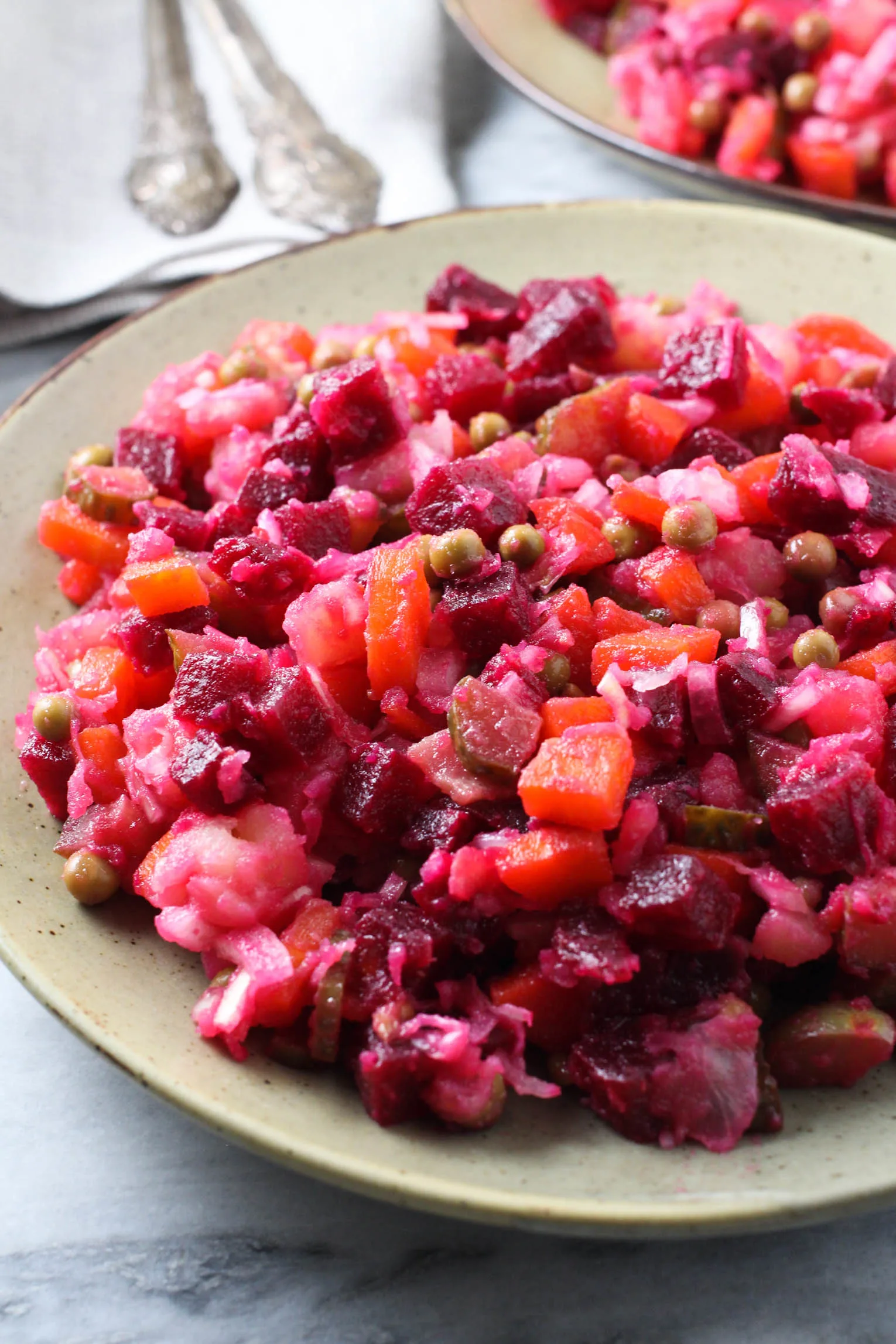
Variations
Although the main ingredients used in this Russian beet salad remain the same, there is room for some variations:
- Oil options – Unrefined sunflower oil is commonly used in Russian cuisine, but you can substitute other mild-flavored oils like olive oil or avocado oil if you like.
- Incorporate acidity – Add a splash of vinegar, a squeeze of fresh lemon juice, or some of the brine from the pickles or sauerkraut to create a more well-rounded final flavor.
- Add fresh herbs – Sprinkle chopped fresh parsley, dill, green onion, or cilantro over the top before serving to brighten the salad and improve its presentation.
- Optional add-ins – Add flavor-enhancing ingredients, like diced green apple, green onions, marinated mushrooms, capers, red kidney beans, chickpeas, bell peppers, radishes, hard-boiled eggs, or mustard.
Storing
Keep leftover Russian vinaigrette salad in an airtight container in the fridge for 2-3 days. Do not freeze.
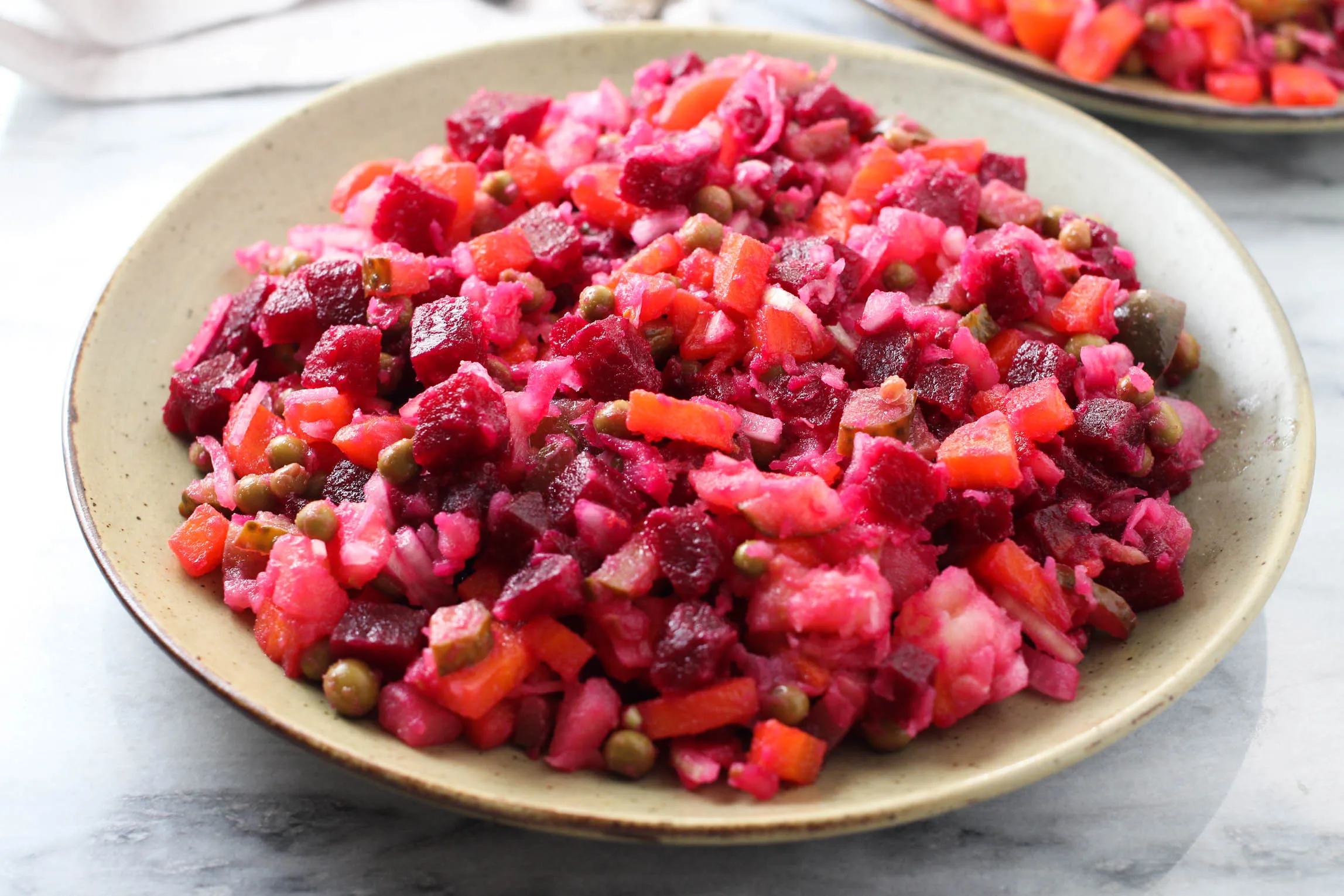
Frequently Asked Questions
Here are a few related questions about vinegret salad:
Can I cook the vegetables in the Instant Pot?
Yes! Instant Pot is perfect for cooking vegetables for vinaigrette salad. However, I recommend cooking the vegetables separately because beets, potatoes, and carrots will finish cooking at different times.
Can you cook beets with potatoes and carrots in the same pot?
You can, but I don’t recommend it because you’ll need a larger pot, and beets take longer to cook.
It’s easy to miss when the carrots and potatoes must be removed from the boiling water before they start overcooking.
Additionally, the beet pigment will bleed into the water and alter the color of the potatoes and carrots. That said, feel free to cook them all together if you’re okay with these caveats.
What is the history of vinegret?
While its exact origins are unclear, the legend has it that the vinegret salad gained popularity and became a staple Russian dish in the early 19th century.
The salad was a perfect way to make use of readily available, affordable, and nutritious ingredients. Over time, the dish became a time-honored Russian tradition for New Year’s Eve and other festive occasions.
More Russian Recipes
If you are looking to try more Russian dishes, check out these recipes:
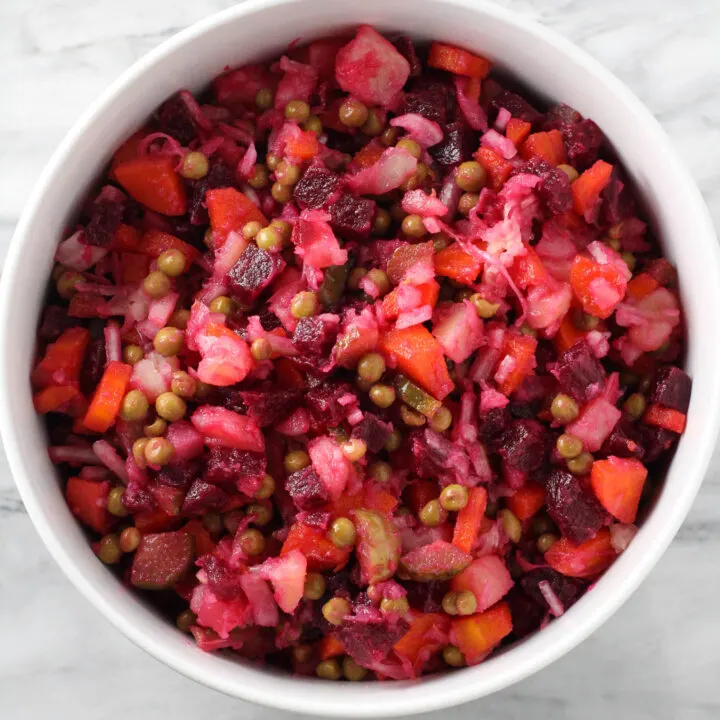
Russian Vinaigrette Salad (Beet and Potato Salad Recipe)
This beet potato salad is a popular dish in Eastern European cuisine. It's easy to make and will last you a few days. Made with root vegetables, this delicious salad is very filling and comforting.
Ingredients
- 4-5 medium beets
- 2-3 medium carrots
- 4-5 medium potatoes
- 2-3 medium pickles (about 1 cup diced pickles)
- 1 cup sauerkraut, drained
- 1 small onion, thinly sliced
- 1 can ( 14 oz/398 ml) green peas, drained
- 3 Tbsp unrefined sunflower oil or olive oil
- salt to taste
Instructions
- Add water and beets to a medium pot, making sure the beets are covered by at least 3 inches of water. Bring the water to a boil. Reduce the heat, cover, and cook the beets for about 1 to 1 1/2 hours or until they are tender.
- Add water, potatoes, and carrots to another pot, making sure the vegetables are covered by at least 2 to 3 inches of water. Bring the water to a boil. Reduce the heat, cover, and cook the vegetables for about 25 to 35 minutes until they are tender. Make sure not to overcook the potatoes.
- Let the vegetables cool completely. I recommend leaving them in the refrigerator overnight so that the potatoes firm up a bit.
- Peel and dice the potatoes, beets, and carrots. Squeeze the extra liqueed from the pickles and dice them. Slice the onion.
- In a large mixing bowl, add the vegetables, pickles, sauerkraut, onion, green peas, and oil. Season with salt to taste. Toss to combine. Chill in the fridge for about 30 minutes to 1 hour before serving.
Nutrition Information
Yield 5 Serving Size 1/5 of recipeAmount Per Serving Calories 333Total Fat 12gSaturated Fat 1gTrans Fat 0gUnsaturated Fat 10gCholesterol 0mgSodium 609mgCarbohydrates 52gFiber 9gSugar 10gProtein 8g
Nutrition facts provided on this website are an estimate and not guaranteed to be accurate. Please see a qualified health care provider for personalized diet advice and make sure that each of the ingredients is allowed in your diet.
